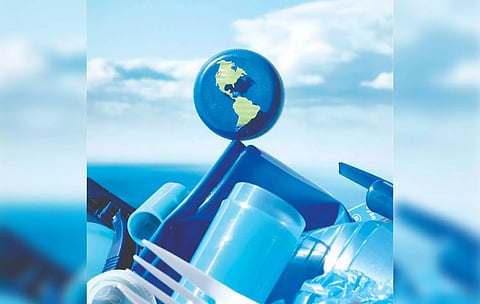Dangerous Addiction: Keeping plastic out of our oceans
By Boyan Slat
NEW YORK: The world is finally getting serious about plastic pollution. Next week, delegates from UN member states will gather in Paris to debate the shape of what some hope will become the plastic-pollution equivalent of the Paris Climate Agreement. There is no time to waste.
Plastic is one of the biggest threats our oceans face today, causing untold harm to ecosystems, tremendous economic damage to coastal communities and posing a potential health threat to more than three billion people dependent on seafood.
The UN Environment Program has put forward a proposal to keep plastics in circulation as long as possible through reuse and recycling. Some activists and scientists advocate capping and reducing plastic production and use.
I share the desire for real long-term change, and all proposals should be considered. But if we are to halt the flow of plastic into our oceans in the near future, then we must focus our actions on the polluting rivers that carry most of it there. In 2011, when I was 16, I went scuba diving during a family holiday in Greece, excited to experience the eternal beauty of our ocean and its wildlife.
I saw more plastic bags than fish. It was a crushing disappointment. I asked myself, “Why can’t we just clean this up?” Naive? Perhaps. But I set out to try. By 2013 I had founded The Ocean Cleanup, a nonprofit funded by donations and a range of philanthropic partners with the mission to rid the oceans of plastic. It made sense to target what is perhaps the most glaring symbol of our oceanic plastic problem, the Great Pacific Garbage Patch, an expanse in the North Pacific Ocean more than twice the size of Texas where bottles, buoys and other plastic refuse accumulates because of converging currents.
Working in harsh oceanic conditions is a challenge, and we have encountered our share of setbacks. What kept us going were the scenes our crews encountered at sea: dissected fish whose guts were full of sharp plastic fragments, and sea turtles entangled in abandoned fishing nets. Eventually, in 2021, we managed to get our system to work. Two boats pull a U-shaped barrier — our latest version is almost a mile long — through the water at a slow speed, which funnels plastic into a collection area. The waste is pulled out, taken to shore, and recycled. We take great care to ensure that our cleanup efforts don’t harm the marine ecosystem. Images of heaps of plastic being pulled from the ocean have led to accusations — never substantiated — that they were staged. But the tons of plastic that we gather are all too real.
We are still at the pilot stage, but by our estimates, we’ve removed more than 0.2 percent of the plastic in the patch so far and our systems are only getting better. We have a long way to go, but we are making progress. Cleaning up ocean garbage patches is critical. But if we don’t also stop more plastic from flowing into the oceans, we will never be able to get the job done. Since the introduction of plastics in the first half of the 20th century, demand has grown exponentially. Estimates vary, but each year about 400 million tons of plastic is being produced, roughly equal to the weight of more than 1,000 Empire State Buildings. (Somewhere between nine million and 14 million metric tons is believed to enter aquatic ecosystems per year).
Truly meaningful reductions in plastic use will be difficult to achieve. The environmental scientist Vaclav Smil has called plastic one of the four “pillars of modern civilization.” It’s become a necessity of modern life, its unique combination of lightness, durability, and low cost providing undeniable utility and a level of convenience that we’ve become dependent upon.
As the world’s population expands and more people rise out of poverty and into more consumer-oriented lifestyles, demand for plastic-packaged goods will inevitably grow. The Organization for Economic Cooperation and Development predicts plastic use will nearly triple by 2060 at the current rate, with most of the growth occurring outside Europe and the United States.
Economist Impact and the Nippon Foundation’s Back to Blue Initiative modeled policy scenarios for reducing plastic production by 2050 — none of them resulted in a production rate lower than what we see today.
Places like Canada and the European Union have banned “single-use” items like plastic cutlery, coffee stirrers, and cotton swabs. But while laudable, these policies only slightly reduce consumption, not nearly enough to offset anticipated growth in the years ahead.
Realistically, we need to prepare for a future in which humanity uses more plastic, not less. One answer is to improve waste management. Residents of Europe, the United States, Japan, and South Korea are among the most prolific users of plastic, consuming about one-third of the global total, yet those countries are directly responsible for only around 1 percent of what leaks into the ocean, partly because of their relatively well-functioning systems for waste collection and disposal. But waste management lags behind in many middle - and lower-income countries and that’s the main reason Asia, West Africa, and Latin America are, according to our findings, the plastic pollution hot spots of the world.
A world in which every city has excellent garbage collection and disposal systems is the ultimate goal. But waste management is expensive. Upgrading systems around the world to the level of rich nations could take decades. In the meantime, thousands of tons of plastic continue to flow into the ocean every day, nearly all of it carried there by rivers. Our research looked at more than 100,000 of the world’s rivers and streams and found that nearly 80 percent of all plastic leaking into the ocean comes from just 1,000 of those rivers or 1 percent.
In a way, this is good news because it allows us to pinpoint the major sources of pollution and intercept it. When you factor in that this leakage amounts to only a small fraction of the total amount of plastic that is produced worldwide, we have a real opportunity to rapidly turn off the tap, buying time until global waste management can be improved
We’re already working on this. The Ocean Cleanup is intercepting trash in 10 polluting rivers in countries including Indonesia, Malaysia, Vietnam, the Dominican Republic, and the United States. A range of other organizations are doing similar work.
But if we want a plastic-free ocean, we should start by focusing on areas where our leverage is greatest. Interception in rivers is the fastest and most cost-effective way to prevent plastic from reaching the ocean and the most pragmatic way to address this problem with the urgency it demands.
Effective solutions exist, and the world’s governments have a moral obligation to scale them up rapidly so that humanity can finally clean up its mess.

